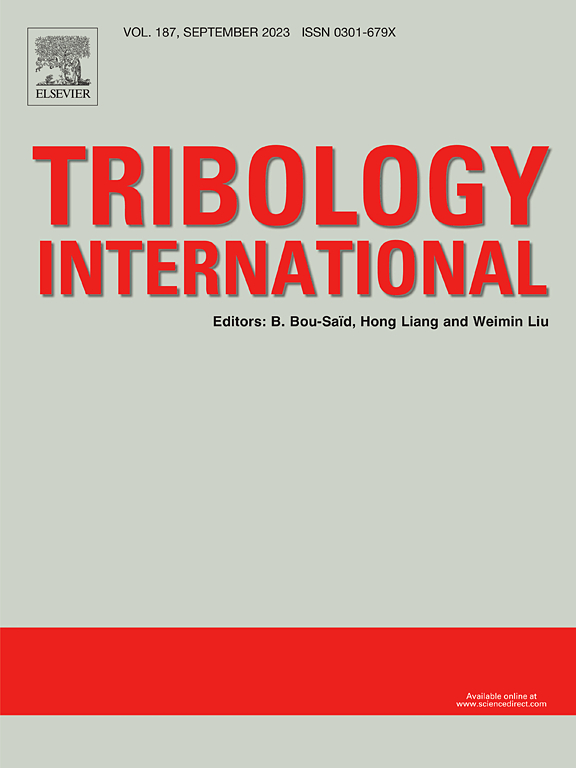Formation of interlayer during cyclic wear process between pure titanium with hydroxiapatite by mechano-chemical interactive migration
IF 6.1
1区 工程技术
Q1 ENGINEERING, MECHANICAL
引用次数: 0
Abstract
The estimation of nanoscale wear is crucial for comprehending the failure mechanisms of mechanical components, particularly in biomedical applications where wear-induced damage at the implant interface can result in aseptic loosening and failure. Although recent wear models effectively estimate wear coefficients, they exhibit limitations in accounting for the inelastic deformation and diffusion at the interlayer. A comprehensive understanding of interlayer formation and its impact is essential for elucidating the interplay between the mechanical and chemical effects in fretting wear behavior, which is vital for enhancing the longevity of mechanical components and implants. This study aims to examine the cyclic wear behavior of Ti in contact with a HAp surface under normal load by integrating mechanical and chemical influences. Three loading cycles, including the approach-retraction process of Ti spheres on the HAp surface, were simulated using Molecular Dynamics (MD) simulations with a reactive force field and the charge equilibrium method. The predominance of charge migration and the interactive effects of mechanical diffusion and charge migration on the local wear behavior were examined by analyzing the influence of temperature and charge variation on the Ti wear rate. Heterogeneous cyclic wear behavior was observed, with severe wear activation during contact formation followed by reduced wear owing to the charged Ti interlayer. This finding underscores the role of the interlayer in enhancing the wear resistance, emphasizing the necessity of incorporating surface chemistry and mechanical deformation in predictive wear modeling.

纯钛与氢磷灰石循环磨损过程中机械-化学相互迁移形成的中间层
纳米磨损的估计对于理解机械部件的失效机制至关重要,特别是在生物医学应用中,植入物界面的磨损引起的损伤可能导致无菌松动和失效。虽然最近的磨损模型有效地估计了磨损系数,但它们在考虑层间的非弹性变形和扩散方面存在局限性。全面了解层间形成及其影响对于阐明微动磨损行为中机械和化学效应之间的相互作用至关重要,这对于提高机械部件和植入物的使用寿命至关重要。本研究旨在通过综合机械和化学影响来研究钛在正常载荷下与HAp表面接触的循环磨损行为。采用分子动力学(MD)模拟方法,结合反作用力场和电荷平衡方法,模拟了钛球在HAp表面的接近-缩回过程。通过分析温度和电荷变化对Ti磨损率的影响,探讨了电荷迁移的主导作用以及机械扩散和电荷迁移对局部磨损行为的交互作用。观察到非均匀循环磨损行为,在接触形成过程中出现严重的磨损激活,然后由于带电Ti中间层而减少磨损。这一发现强调了中间层在提高耐磨性方面的作用,强调了在预测磨损建模中结合表面化学和机械变形的必要性。
本文章由计算机程序翻译,如有差异,请以英文原文为准。
求助全文
约1分钟内获得全文
求助全文
来源期刊

Tribology International
工程技术-工程:机械
CiteScore
10.10
自引率
16.10%
发文量
627
审稿时长
35 days
期刊介绍:
Tribology is the science of rubbing surfaces and contributes to every facet of our everyday life, from live cell friction to engine lubrication and seismology. As such tribology is truly multidisciplinary and this extraordinary breadth of scientific interest is reflected in the scope of Tribology International.
Tribology International seeks to publish original research papers of the highest scientific quality to provide an archival resource for scientists from all backgrounds. Written contributions are invited reporting experimental and modelling studies both in established areas of tribology and emerging fields. Scientific topics include the physics or chemistry of tribo-surfaces, bio-tribology, surface engineering and materials, contact mechanics, nano-tribology, lubricants and hydrodynamic lubrication.
 求助内容:
求助内容: 应助结果提醒方式:
应助结果提醒方式:


